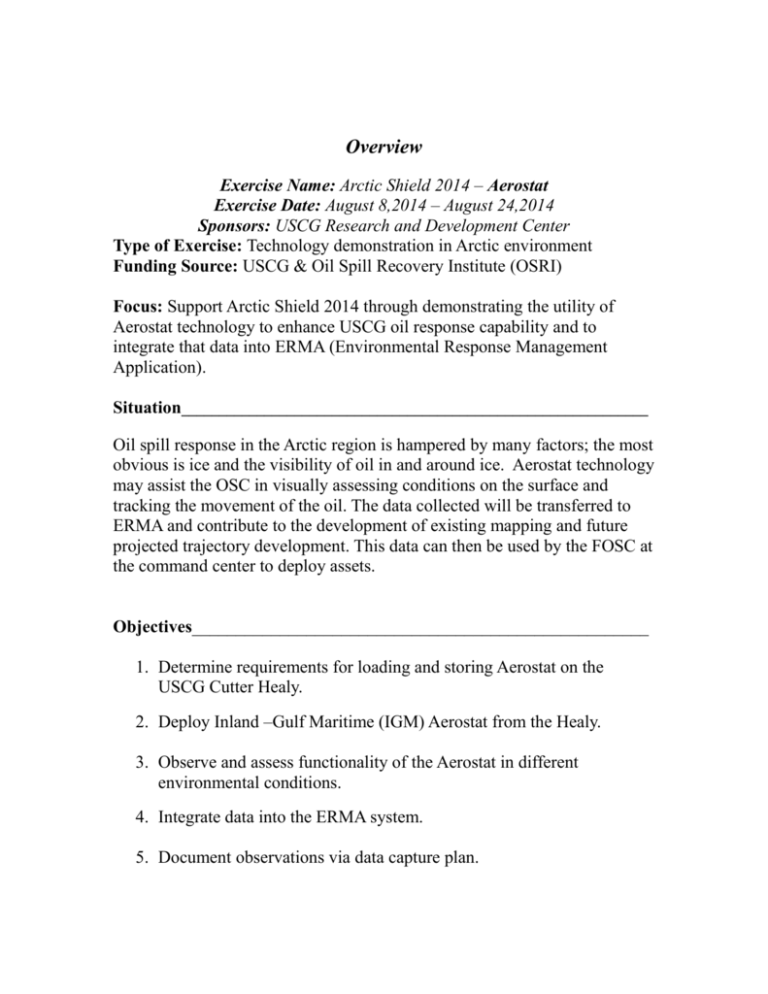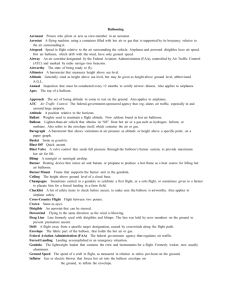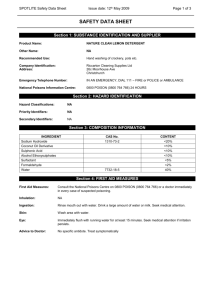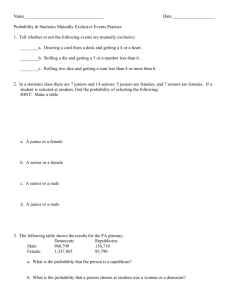AS2014 Aerostat AAR..
advertisement

Overview Exercise Name: Arctic Shield 2014 – Aerostat Exercise Date: August 8,2014 – August 24,2014 Sponsors: USCG Research and Development Center Type of Exercise: Technology demonstration in Arctic environment Funding Source: USCG & Oil Spill Recovery Institute (OSRI) Focus: Support Arctic Shield 2014 through demonstrating the utility of Aerostat technology to enhance USCG oil response capability and to integrate that data into ERMA (Environmental Response Management Application). Situation______________________________________________________________ Oil spill response in the Arctic region is hampered by many factors; the most obvious is ice and the visibility of oil in and around ice. Aerostat technology may assist the OSC in visually assessing conditions on the surface and tracking the movement of the oil. The data collected will be transferred to ERMA and contribute to the development of existing mapping and future projected trajectory development. This data can then be used by the FOSC at the command center to deploy assets. Objectives____________________________________________________ 1. Determine requirements for loading and storing Aerostat on the USCG Cutter Healy. 2. Deploy Inland –Gulf Maritime (IGM) Aerostat from the Healy. 3. Observe and assess functionality of the Aerostat in different environmental conditions. 4. Integrate data into the ERMA system. 5. Document observations via data capture plan. Participating Organizations____________________________________________________ USCG RDC, Healy, Oil Spill Recovery Institute (OSRI), Inland-Gulf Maritime Planning Team___________________________________________________________________ LCDR Bill Woityra Operations Officer CGC HEALY 206-217-6300 RDC Arctic Shield 2014 Team Mike Coleman 860-271-2708 Inland-Gulf Maritime Chris Wiggins Operations____________________________________________________ 06 Aug 2014 – Locate Aerostat container box and all other materials on pier at Seward, AK. Work with Inland Gulf Maritime representative to have forklift deliver to port side of Healy. Use Healy’s portside 04 crane to lift Aerostat Box onto flight deck and use two pallet jacks to move into helicopter hangar. 07 -09 Sep 2014 – Work with IGM personnel to unpack and check out all Aerostat equipment. 10 Aug 2014 – Coordination meeting with IGM, ERMA, RDC personnel to discuss and test data transfer (i.e. video, geo-tagged still photos). 11 Aug 2014 – Continue to test data transfer between Aerostat and ERMA. Prepare and give brief to science party during after dinner lecture period. Prepare for test deployment off of Nome. 12 Aug 2014 – Deploy Aerostat to an altitude of 500 ft. off Healy flight deck after anchoring 3 miles off of Nome. Once deployed, commenced communications check and discovered some GPS issues which required the Aerostat to be retrieved, and corrective action taken. Redeployed Aerostat to 250 ft and continued communications test. Retrieved Aerostat at end of day, and then moved the box and balloon back into the flight hangar. 13-15 Aug 2014 – In transit from Nome to Arctic Circle test area. Meet with IGM personnel to discuss test flight results and future testing days. Meet with ERMA personnel to discuss their needs and if there are any issues with getting the Aerostat data onto ERMA. Mounted Aerostat camera near HCO on 04 deck for several days to confirm data transmission to computer lab on 01 deck. 16 Aug 2014 - Moved Aerostat out of hangar and prepared for deployment. Page 2 of 4 Wind speeds were 18-20 kts on deck. PUMA flight confirms wind speed at 500 ft at 25 kts which is above Aerostat threshold. PUMA decides to land due to wind. Aerostat decides against flying at that time and waits for lower winds later in the day that never come. Decided to leave Aerostat box secured to flight deck, and store balloon in hangar overnight. 17Aug 2014 – Coordinated with IGM and ERMA to continue data transmission continuity. 18 Aug 2014 – Deployed Aerostat on 2nd flight in foggy, misty conditions to approximately 300 ft. Attempted to track oranges, green dye simulant and oil tracking buoys that were deployed off the ASB. Could not track stimulants due to visibility issues and distance to target. Lowered the Aerostat several times to clean the camera lens due to water condensation. 19 Aug 2014 – Deployed Aerostat to 500 ft to look for oil tracking buoys located 1 ½ to 2 miles away. Visibility conditions were great and wind was light. Could not locate buoys due to distance. Oranges, dye and thermal Oscar were deployed in the afternoon near the Healy (500 yds off starboard). The Aerostat tracked the oranges and dye and passed that data to ERMA. 20 Aug 2014 – Prepared Aerostat for launch to support search for ONR buoy. Low visibility all day prevented the Aerostat from being utilized. 21 Aug 2014 - Prepared Aerostat for launch to support search for DARPA buoy, but was never deployed. Lessons Learned_______________________________________________ 1. Visibility and wind speed are the main limiting factors on utilizing the Aerostat capabilities. 2. Aerostat container movement from the hangar to the flight deck is manageable if planned properly and have proper equipment. Can leave Aerostat box secured to the flight deck, exposed to weather, while in transit and store balloon in hangar deck. 3. Need several different balloon options for deployment depending on weather conditions such as low or high wind speeds. 4. Need several different option s of cameras depending on mission requirements.(ie. Distance to and size of target, field of view,etc.) Page 3 of 4 5. Situational awareness of where the balloon and tether are located is essential due to wind shifts, crane operations and other possible interferences on board. 6. Need clear defined requirements for camera capabilities ;( i.e. capability to find a 16” buoy at 1 ½ miles.) 7. Several trained operators of the camera equipment are necessary if operations will last greater than 24 hours. 8. Communication between the Aerostat control on deck and the camera control in the computer lab is essential. Conclusion____________________________________________________ 1. Aerostat operations can be successful in the Arctic region. However, challenges will include wind speed, visibility and camera capabilities. 2. Data from the Aerostat can be integrated into ERMA and provide the decision makers another data source to direct assets in a spill response. 3. Operating requirements such as maximum wind speed and distance to targets have to clear and specified. 4. Providing different camera systems and balloon options that can be deployed depending on conditions will make the Aerostat system the most useful. Recommended Future Actions___________________________________ 1. Assess the capability of smaller sized Aerostat packages that can be deployed on a smaller separate response vessel that will be located directly on scene of the simulated spill. Test capability to deliver video input and communications to command vessel for integration into ERMA 2. Assess different cameras options and different balloon configurations on current and smaller sized Aerostat systems. Page 4 of 4







